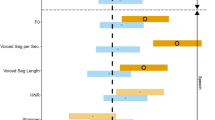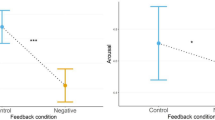Abstract
The recently proposed restorative environments have the potential to restore attention and help against fatigue, but how can these effects be verified? We present a novel measurement method which can analyze participants’ speech signals in a study before and after a relaxing experience. Compared to other measurements such as attention scales or response tests, speech signal analysis is both less obtrusive and more accessible. In our study, we found that certain time- and frequency- domain speech features such as short-time energy and Mel Frequency Cepstral Coefficients (MFCC) are correlated with the attentional capacity measured by traditional ratings. We thus argue that speech signal analysis can provide a valid measure for attention and its restoration. We describe a practically feasible method for such a speech signal analysis along with some preliminary results.
Access this chapter
Tax calculation will be finalised at checkout
Purchases are for personal use only
Similar content being viewed by others
References
Benesty, J., Chen, J., Huang, Y., Cohen, I.: Pearson correlation coefficient. In: Noise Reduction in Speech Processing, pp. 1–4. Springer, Vienna (2009). https://doi.org/10.1007/978-3-211-89836-9_1025
Biesmans, W., Das, N., Francart, T., Bertrand, A.: Auditory-inspired speech envelope extraction methods for improved EEG-based auditory attention detection in a cocktail party scenario. IEEE Trans. Neural Syst. Rehabil. Eng. 25(5), 402–412 (2016)
Braun, M., Weiser, S., Pfleging, B., Alt, F.: A comparison of emotion elicitation methods for affective driving studies. Presented at the (2018)
Carreiras, C., Lourenço, A., Aidos, H., da Silva, H.P., Fred, A.L.N.: Unsupervised analysis of morphological ECG features for attention detection. In: Madani, K., Dourado, A., Rosa, A., Filipe, J., Kacprzyk, J. (eds.) Computational Intelligence. SCI, vol. 613, pp. 437–453. Springer, Cham (2016). https://doi.org/10.1007/978-3-319-23392-5_24
Cimprich, B., Visovatti, M., Ronis, D.L.: The attentional function index-a self-report cognitive measure. Psychooncology 20(2), 194–202 (2011)
Dhupati, L.S., Kar, S., Rajaguru, A., Routray, A.: A novel drowsiness detection scheme based on speech analysis with validation using simultaneous EEG recordings, pp. 917–921. IEEE (2010)
Franěk, M., Šefara, D., Petružálek, J., Cabal, J., Myška, K.: Differences in eye movements while viewing images with various levels of restorativeness. J. Environ. Psychol. 57, 10–16 (2018)
Gao, B., Woo, W.L.: Wearable audio monitoring: content-based processing methodology and implementation. IEEE Trans. Hum. Mach. Syst. 44(2), 222–233 (2014)
Gunn, S.R., et al.: Support vector machines for classification and regression. ISIS Technical Report 14(1), 5–16 (1998)
Guo, G., Wang, H., Bell, D., Bi, Y., Greer, K.: KNN model-based approach in classification. In: Meersman, R., Tari, Z., Schmidt, D.C. (eds.) OTM 2003. LNCS, vol. 2888, pp. 986–996. Springer, Heidelberg (2003). https://doi.org/10.1007/978-3-540-39964-3_62
Hogg, A.O., Evers, C., Naylor, P.A.: Speaker change detection using fundamental frequency with application to multi-talker segmentation, pp. 5826–5830. IEEE (2019)
Jalil, M., Butt, F.A., Malik, A.: Short-time energy, magnitude, zero crossing rate and autocorrelation measurement for discriminating voiced and unvoiced segments of speech signals, pp. 208–212. IEEE (2013)
Jiang, D., Hu, B., Chen, Y., Xue, Y., Li, W., Liang, Z.: Recognizing the human attention state using cardiac pulse from the noncontact and automatic-based measurements. Soft. Comput. 22(12), 3937–3949 (2018)
Jingyi, L., Yong, M., Puzhen, L., Andreas, B.: A journey through nature: exploring virtual restorative environments as a means to relax in confined spaces. Association for Computing Machinery, New York, NY, USA (2021)
Joshi, D.D., Zalte, M.: Speech emotion recognition: a review. IOSR J. Electron. Commun. Eng. (IOSR-JECE) 4(4) (2013)
Lam, K.Y., et al.: Smartmood: toward pervasive mood tracking and analysis for manic episode detection. IEEE Trans. Hum. Mach. Syst. 45(1), 126–131 (2014)
Li, X., Tan, N., Wang, T., Su, S.: Detecting driver fatigue based on nonlinear speech processing and fuzzy SVM, pp. 510–515. IEEE (2014)
Maurya, A., Kumar, D., Agarwal, R.: Speaker recognition for Hindi speech signal using MFCC-GMM approach. Procedia Comput. Sci. 125, 880–887 (2018)
Narayanan, A.M., Bertrand, A.: Analysis of miniaturization effects and channel selection strategies for EEG sensor networks with application to auditory attention detection. IEEE Trans. Biomed. Eng. 67(1), 234–244 (2019)
Ohly, H., et al.: Attention restoration theory: a systematic review of the attention restoration potential of exposure to natural environments. J. Toxicol. Environ. Health, Part B 19(7), 305–343 (2016)
Popov, D., Gapochkin, A., Nekrasov, A.: An algorithm of Daubechies wavelet transform in the final field when processing speech signals. Electronics 7(7), 120 (2018)
Rocha, R.B., Freire, V.V., Alencar, M.S.: Voice segmentation system based on energy estimation, pp. 860–864. IEEE (2014)
Schuller, B.W.: Intelligent Audio Analysis. Signals and Communication Technology, Springer, Heidelberg (2013). https://doi.org/10.1007/978-3-642-36806-6
Stevenson, M.P., Schilhab, T., Bentsen, P.: Attention restoration theory ii: a systematic review to clarify attention processes affected by exposure to natural environments. J. Toxicol. Environ. Health Part B 21(4), 227–268 (2018)
Stone, R., Small, C., Knight, J., Qian, C., Shingari, V.: Virtual natural environments for restoration and rehabilitation in healthcare. Virtual Augment. Real. Ser. Games Healthc. 1, 497–521 (2014)
Sun, Y.X., Ma, Y., Shi, K.B., Hu, J.P., Zhao, Y.Y., Zhang, Y.P.: Unsupervised speaker segmentation framework based on sparse correlation feature, pp. 3058–3063. IEEE (2017)
Visuri, A., van Berkel, N.: Attention computing: overview of mobile sensing applied to measuring attention. Presented at the (2019)
Wieland, B., Urban, K., Funken, S.: Speech signal noise reduction with wavelets. Verlag nicht ermittelbar, Ph.D. thesis (2009)
Wilcoxon, F.: Individual comparisons by ranking methods. In: Kotz, S., Johnson, N.L. (eds.) Breakthroughs in Statistics, pp. 196–202. Springer, New York (1992). https://doi.org/10.1007/978-1-4612-4380-9_16
Woods, D.L., et al.: Improving digit span assessment of short-term verbal memory. J. Clin. Exp. Neuropsychol. 33(1), 101–111 (2011)
Yang, Y., et al.: Kullback-Leibler divergence frequency warping scale for acoustic scene classification using convolutional neural network, pp. 840–844. IEEE (2019)
Yella, S.H., Stolcke, A., Slaney, M.: Artificial neural network features for speaker diarization, pp. 402–406. IEEE (2014)
Acknowledgements
We thank all study participants for their time and effort, as well as our anonymous reviewers for their valuable feedback. Y.M.’s contributions were funded by the China Scholarship Council (CSC), grant number 201706070119.
Author information
Authors and Affiliations
Corresponding author
Editor information
Editors and Affiliations
Rights and permissions
Copyright information
© 2021 IFIP International Federation for Information Processing
About this paper
Cite this paper
Ma, Y., Li, J., Drewes, H., Butz, A. (2021). You Sound Relaxed Now – Measuring Restorative Effects from Speech Signals. In: Ardito, C., et al. Human-Computer Interaction – INTERACT 2021. INTERACT 2021. Lecture Notes in Computer Science(), vol 12933. Springer, Cham. https://doi.org/10.1007/978-3-030-85616-8_34
Download citation
DOI: https://doi.org/10.1007/978-3-030-85616-8_34
Published:
Publisher Name: Springer, Cham
Print ISBN: 978-3-030-85615-1
Online ISBN: 978-3-030-85616-8
eBook Packages: Computer ScienceComputer Science (R0)





